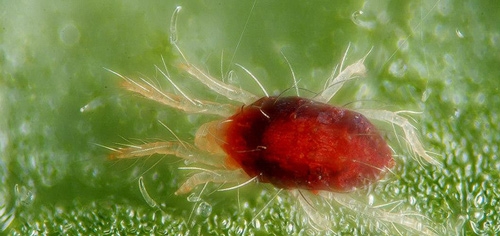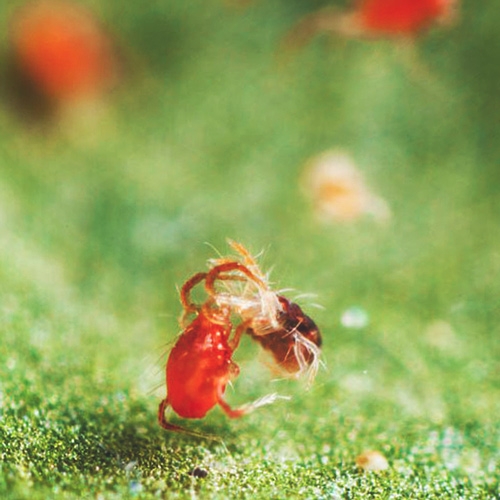
Are you seeing dark dots or spider webs appearing on the leaves of your cannabis plant? Then you need to act swiftly! There’s a good chance that your weed plants are infected with spider mites. In worst cases, that can even result in your weed plants dying back. We’ll tell you how to recognise spider mites and what you can do about the tiny creatures.

Do you just want to know how to deal with spider mites? In that case, scroll down to the final section of this blog.
What is a Spider Mite?
Spider mites are tiny orangey-red creatures which often appear on the underside of cannabis plant leaves. Spider mites (tetranychus urticae) are an infection of mites on plants. The tiny creatures often leave a trail of spidery webs behind themselves. You must deal with spider mites as fast as possible because mite infections are renowned for the rapid speed with which they can spread across (all your) plants. Spider mites mostly occur under hot and dry conditions.
Very young spider mites may be under a millimetre in size. This means you can’t easily see them with the naked eye. You can recognise their presence by the dark dots they leave behind on leaves. At a later stage, the creatures can become 0.5 to 0.8 cm in size. Are they already that big? Then you clearly have a big problem.

Spider Mite
Consequences of Spider Mites
These are the characteristics of a spider mite infection in an initial infestation, a medium-sized infestation and a large infestation.
- In an initial infestation you can recognise spider mites by the dark dots on your leaves. Spider mites bite into the leaf to feed on the plant’s nutrients. As a result the leaves die back. You won’t notice the creatures that quickly because they are very small. In some cases, spider mites nest in their spidery white webs during an initial infestation. You often find these on the underside of the leaves.
- In a medium-sized infestation you’ll see that the leaves are dying back as a result of the feeding. They turn yellow and hang. And you’ll also see large numbers of the white webs. Spider mites try to destroy the leaves and buds of your weed plant. This will make the plant grow slower. The rate of growth tails off.
- A large infestation is impossible to miss. Leaves and buds are completely covered in white webs. The buds no longer bloom and the plant’s flowering is severely disrupted. An extremely large infestation can be an upsetting sight due to the large white haze between your plants. In the worst case, spider mites can cause your entire plant to die off. This is fairly unusual but it can happen.
Note: spider mites multiply very quickly. An infestation grows exponentially. Within a few days the initial mite signs can develop into a medium-sized infestation. So folks, if you see spider mites: act fast!
How to combat spider mites?
There are many ways to combat spider mites. Don’t wait until you can get pesticides. That can take days and by then the damage will already be done. These pesticides are often full of chemicals. This is not the way for natural cultivation.
We set out a number of ways in which to combat spider mites. Before you start, remember that spider mites love the warm and the dry. Try to cool the air in your cultivation room and keep your plants damp. That prevents spider mites. Prevention is better than cure. But note: cold cultivation rooms are dangerous. At too low a temperature, the plants can be damaged. The different methods for combating:
- Garlic. This is a really quick and simple method to combat spider mites. This will only help in the case of an initial to medium-sized infestation. For this method, place a potted garlic plant near the stem of your weed plant. Then water the garlic plant so that it releases its smell. You can also choose to put a number of garlic cloves next to the stem (i.e. in the soil) of your weed plant. Pour the water that you give your weed plant over the garlic cloves. You’ll see that this leads to a result. You can leave the garlic in place for a while. Make sure to get them out of your planter about 3 weeks prior to the end of flowering. Otherwise your weed might acquire a garlic smell.
- Predatory mites, ladybirds or lacewings. This is a highly effective control method. Predatory mites, ladybirds and lacewings are natural enemies of spider mites. Predatory mites, for example: these creatures eat all the spores of spider mites. As soon as the infestation has been destroyed, the predatory mites eat each other. The other creatures work in similar ways. Ladybirds eat far more creatures than just spider mites alone and are more often used to combat different insects. The creatures can be obtained at garden centres or health shops (also online). Act swiftly because with spider mites there is no time to be lost. Is it going to take too long before you get hold of the creatures? Then you should go for a different control method.

Predatory mite in fight with Spider Mite
- Pruning & spraying. This is a method which needs to be carried out thoroughly. It’s also quite time consuming. But it’s very effective if done properly. Start by pruning leaves and branches where spider mites are found. Don’t cut along the edge of the dark spots or webs but remove a substantial part (i.e. the branch as well). For an optimal result you need to remove a large part of the plant. This is the best way to prevent the infestation from spreading to the rest of your crop. After you’ve pruned the plant, proceed to carefully wash it down. Don’t do this with a powerful hose but use a fine plant spray. By spraying it you’ll wash all the remaining mites away. The disadvantage of this method is that you have to throw away part of your plants. And you have to work really thoroughly. Any little bit left over can lead to a new outbreak.
- Cinnamon water. This is often applied to combat fungus gnats. But you can also use this against spider mites. Cinnamon water is ready within 45 minutes. So it’s always worth a try. Do you want to know how to make cinnamon water? Look here for the recipe.
- Natural oils. You can decide to use natural oil to combat spider mites. You usually mix the oil in water and spray this over your weed plants. Natural oils can be: cinnamon oil, eucalyptus oil, neem oil, etc. These oils aren’t available everywhere and so it might take time to get hold of them. Another disadvantage of this method is that the taste of the oil can infiltrate the weed. Are you considering this method? Then try to spray the buds as little as possible.
- Biological pesticides. There are many biological control agents against spider mites. These agents are expensive and you usually have to buy a large quantity. Moreover, they usually have to be ordered which means you won’t get them straight away.
Other Leaf Problems in Weed Plants
Spider mites are not the only problem which can occur during cannabis cultivation. Do you want to know all there is to know? Then read our blogs about leaf problems in cannabis plants:
- Part 1: preventing problems
- Part 2: recognising issues
- Part 3: life-threatening diseases
